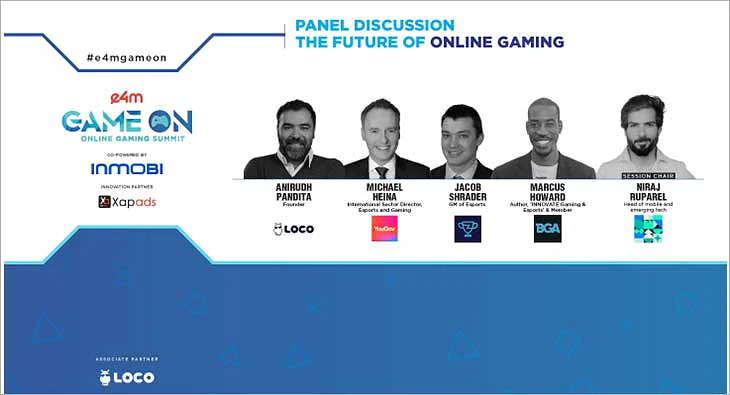The Future of Esports: A Look into the Growing Phenomenon
SOURCE: HTTPS://GAMEISHARD.GG/
OCT 16, 2023
The future of online gaming is in metaverse
SOURCE: EXCHANGE4MEDIA.COM
MAR 14, 2022

Gaming in India is the newest ecosystem for brands, advertisers and A&M agencies to collaborate, and it is with this outlook that e4m organised the GameOn Summit on Friday. The conference explored the exciting synergies and opportunities in the gaming space, bringing together thought leaders from various sectors.
One of the highlights of the event was a panel discussion on the future of online gaming. On the panel were Anirudh Pandita, Founder, Loco; Michael Heina, International Sector Director, Esports and Gaming, YouGov, Germany; Jacob Shrader, GM of Esports at ZenSports, USA; and Marcus Howard, Author, INNOVATE: Gaming & Esports and Member, Blockchain Game Alliance. The session was chaired by Niraj Ruparel, Head of Mobile and Emerging Tech, GroupM.
Underlining the increasingly large role the metaverse plays in gaming and our digital lives in general, Ruparel started the discussion by asking if the session should be conducted in AR (Augmented Reality), VR (Virtual Reality), or MR (Mixed Reality).
“Something that has been really keeping me occupied is creating various experiences on the Metaverse, and getting our brands onboard. Like, India’s first virtual wedding was completely conceptualized by us, and we got Coca-Cola, ITC and a bunch of other brands to be part of it,” Ruparel noted.
Taking the discussion forward, Howard said he was enthusiastic about the role AR, VR, and MR will play in promoting eSports, especially when combined into xR (eXtended Reality). “There is still a stigma against video games, and then by extension eSports. People don't believe that you can be a sports athlete if you're sitting in your chair playing on a console or computer or mobile. And so, what XR creates is the ability to have this full-body motion, full interaction that you associate with traditional sports. In that way, you are having more activity and so it's seen as more acceptable. But then you also extend the amount of engagement opportunities. Extended reality means not only can you have eSports from your home, but you can have it at a restaurant or a stadium.”
The session went on to explore emerging and emerged technologies like NFTs (Non-Fungible Tokens), DeFi (Decentralized Finance), Blockchain, Crypto currencies, 5G, Metaverse, and the role of gaming, and especially esports, will play in making them mainstream.
Indeed, blockchain and DeFi will have huge applications for gaming, said Shrader, explaining, “It basically provides players the ability to tangibly own their assets in games. And because the blockchain is extendable and never sleeps, those assets are much more liquid than assets in video games have ever been before.”
However, because these blockchain games are pretty new, there's only a select few of them that have taken off. “I would say a year and a half ago that was a really big deal and really hard for people to get into blockchain gaming. What we've seen over the last year is card renting, asset renting and the ability for users who have the assets to invest in them to rent to other users. That's huge. And that's what's going to help push blockchain gaming to the masses,” Shrader noted.
Addressing how 5G was going to propel the gaming revolution even further, Pandita said, “The computing power is just going to get faster and better and so it’s going to get a lot more immersive, and people are going to engage further. You already saw it happen with desktops, while the Oculus price point is not too different from that of a mobile phone. So, you’re going to see people going in for more immersive entertainment and, of course, gaming is the easiest and most fun way to engage with that.”
Sharing thoughts on the implications on advertising, Heina observed, “Our data has found that if brands find a way to non-intrusively bring themselves into a game that is the best way to sell something, because it’s not perceived as advertisement, but as part of the game. In Germany, a frozen food brand, which has nothing to do with GTA, put up their branding and products in the stores in the game during Christmas time, and not only did their brand awareness jump, but their consideration rate, as in would people buy their product, went up five times higher than before.”
This not only showed how wide an audience gaming allowed brands to reach, but how, if done effectively, in-game advertising could reap significant returns, Heina noted.
LATEST NEWS

Artificial Intelligence
Deepfakes of your dead loved ones are a booming Chinese business
MAY 07, 2024
WHAT'S TRENDING


Data Science
5 Imaginative Data Science Projects That Can Make Your Portfolio Stand Out
OCT 05, 2022

SOURCE: HTTPS://GAMEISHARD.GG/
OCT 16, 2023
SOURCE: HTTPS://AFKGAMING.COM/
SEP 26, 2023
SOURCE: HTTPS://NEWS.CUMBRIA.AC.UK/
SEP 26, 2023
SOURCE: HTTPS://GEEKSPIN.CO/LENOVO-LEGION-GO/
SEP 01, 2023
SOURCE: WWW.GAMESPOT.COM/
AUG 22, 2023
SOURCE: HTTPS://TECH.HINDUSTANTIMES.COM/
AUG 16, 2023
SOURCE: HTTPS://WWW.SCIENCEDAILY.COM/
AUG 08, 2023